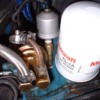Actually you need these THREE pieces:
• one,1/4" NPT plug (this is a male threaded plug, as opposed to a female threaded cap), to fill your old sender location at the rear of the manifold
• one 3/8" NPT nipple about 3" long, to screw into the new location and get the pressure sender away from obstructions. A nipple is always male-threaded at both ends.
• one 3/8" FPT x 1/4" FPT reducer, to place on the end of the nipple and allow you to thread in the pressure sender. FPT = female pipe thread
Total of three pieces. You can buy these at Lowes, Home Depot, Ace, or, as I prefer, your old-time, independently-owned hardware store.
Like Marlin, I highly prefer brass for these items.
Larry
P.S. - NPT stands for National Pipe Thread
P.P.S. - Who the heck is 'Clyde'?







